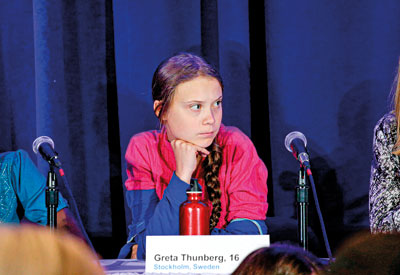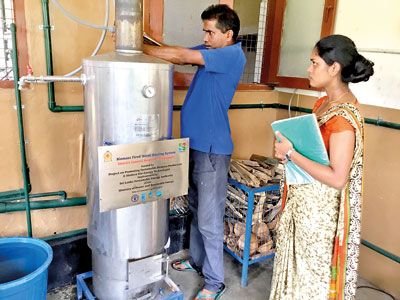Leapfrogging the climate crisis

Activist Greta Thunberg attends a news conference, in New York City. (Photo by Kena Betancur / AFP)
It was a love or hate reaction and both sides equally passionate about sixteen-year-old’s Greta Thunberg’s impassioned speech at the UN Climate Summit this week castigating world leaders with a strident “shame on you!”.
The guilty immediately spoke up. Some world leaders, blamed for their inaction on the climate crisis, notably the leaders of the United States and Australia, downplayed the message and vilified the messenger. The Australian Prime Minister said younger generations have nothing to fear – but they would inherit a strong economy. The right wing media also launched a particularly insulting campaign on the young girl and the other teenagers who have now filed a lawsuit against five leading world economies claiming that developed countries are taking away their future.
Leaving aside the ethics of ‘using’ children to deliver political messages, Greta’s words reverberate in the post-Summit air. For world leaders who have been meeting at world capitals for the past 25 years to listen to scientific warning and make obligatory speeches on their intentions: “You have stolen my dreams and my childhood with your empty words. The eyes of all future generations are upon you. And if you choose to fail us I say we will never forgive you. We will not let you get away with this. Right here, right now is where we draw the line.”
While the internet exploded in waves of applause and ridicule – in almost equal measure — to the girl’s speech and the children’s activism, the UN released damning new scientific evidence. The report updates the scenarios for a warmer world — inevitable now as world leaders renege on their commitments in Paris in 2015 and blame each other for inaction. The scientific evidence pulled together from hundreds of sources spells out large scale impacts on how we live, what we grow, how we source water and food and disasters and diseases.
The report looks at the difference between warming of 1.5 degrees and 2 degrees Celsius to the most sensitive areas on the planet, such as islands, wetlands, coastal areas, glaciers and ice caps. The melting of permafrost in the arctic, accelerated by five years of warm weather, is set to release billions of tons of trapped CO2 in to the air. We are caught in a vicious cycle, and Greta’s warning is not too far off the mark.
The youth of today will inherit an earth quite different to the one we live in now. Basically, imagine that the weather aberrations we are seeing today will double. The rain more intense and the drought deeper and longer. This is the simplest way to imagine the immediate future. The slower, creeping impacts of climate change are much more devastating but are often easily swept under the carpet just because they are not obvious and immediate.

A biomass fired water heating system
Hope lies in a narrow window of time. One year in fact. By 2020, the world must see widespread divorce from fossil fuel and a serious attempt to keep intact our forests, mangroves, jungles, marshes and other natural systems that will help us cope.
Addressing the problem will need more than political will. It will need technological solutions that can help countries meet development ambitions of their people, but without harming the planet: Innovative ways to ‘leapfrog’ the well-established development route paved with fossil-fuel powered technologies.
Emerging technologies such as Big Data, Artificial Intelligence (AI), Blockchain, Mixed Reality and 3D Printing can be used in the public and the private sector to overcome issues in manufacturing, transport, construction and town planning.
Using big data- pulling together information from unconventional data sources—Google has started estimating greenhouse gas emissions for individual cities as part of an ambitious plan to use its valuable data to assist climate-concerned local leaders. So far, the company has only released estimates for five cities, including Pittsburgh, Buenos Aires, and Mountain View in California. Google plans to release its proprietary estimates of a city’s annual driving, biking, and transit ridership, generated from information collected by its popular mapping apps, Google Maps and Waze. The company has never released this kind of aggregate transportation data before, and is willing to share more specific data with local governments to support climate-friendly city transportation systems.
Similarly, IBM has developed a programme that helps cities plan for future heat waves. The programme simulates the climate on an urban scale and explores different strategies to test how well they ease heat waves. For example, if a city wants to plant new trees, machine learning models could determine the best places to plant them to create optimal tree cover and reduce heat from the pavement.
However, there is danger of too much technology concentration in the hands of a few global corporates and countries. If we do not put the right policies and institutions in place, many frontier technologies can potentially do more harm than good. Robots and AI, for example, may eliminate millions of jobs without replacing them with new ones. The creators and owners of such machines will likely become more prosperous at the expense of millions of people.
To get the best outcomes of new technologies, countries on the developing pathway — such as Sri Lanka — need to urgently invest in their capacities for absorption and localising of such technologies. Science and technical education must be ramped up; and additionally, we need to prevent the constant brain drain of our best minds to developed lands and keep the educated younger generation in the country.
Scientists around the world agree that we have enough technologies right now to make the transformation. Energy generation is by far the biggest culprit of CO2 emissions. Renewable energies and energy storage systems are improving by the day. Currently accessible technologies and ones that are still cost-prohibitive will form the basis of the energy transformation bringing down the rule of oil, coal and gas in the next ten years.
Through a project funded by the Global Environmental Facility, UNDP supported the Sri Lankan authorities to review the country’s options on the energy transformation. Some 52 technologies ranging from LED lighting to solar panels to biomass energy replacement and green buildings were reviewed for their cost-benefit, other supplementary benefits (job creation, human health) and for the amount of CO2 they will save. The results were very clear. Time tested and readily available technologies for energy efficiency, such as better air conditioning and refrigeration, converting industrial processes to modern bio-energy and buildings with green technologies are the most viable — economically as well as for emissions reduction. Some of these technologies will give immediate benefit and the conversion cost recovery is less than one year. Of all the technologies, converting coal to LNG was the most costly.
A simple example. Hospitals around the country use hot water for cooking meals and for use in wards. This hot water is generated using LP gas or electricity. We all know that Sri Lanka’s grid is powered with coal and diesel and ‘sometimes’ hydro power. Through a UNDP supported initiative with the Sri Lanka Sustainable Energy Authority (SLSEA), funds invested by the Government in some 20 hospitals, including large hospitals in Kandy, Kurunegala and Moneragala, have now converted their hot water systems to biofuel boilers. The fuel? The waste coconut shells from the kitchen. The cost recovery is less then six months. The combined fuel saving and foreign exchange saving alone makes this a viable investment. The CO2 saving, which was the primary objective, is almost icing on the cake!
So, while robotics and artificial intelligence are important for leapfrogging the crisis, available technologies and some very basic changes can deliver safe and climate-friendly development. It is important to understand that not all change will be economically viable. But we know, as when we save money for the future without knowing what the inflation will be, the investment is likely worth it. The children, you would agree, are likely worth it.
(The writer works as Policy Specialist, Climate Change and Environment of the United Nations Development Programme in Sri Lanka)


